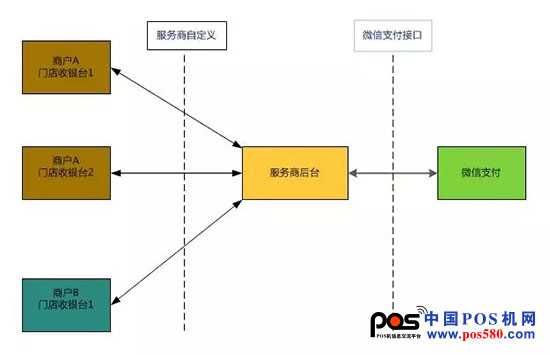Alipay WeChat pays the cashier end solution, the perfect combination of merchants
Many service providers are good at market development, but they don't have the experience of offline access to merchant stores, so many service providers often feel confused at the cashier's end and don't know how to start. They often ask these questions: How does our software integrate with the merchant's cash register system? Do we need to buy a scanner ourselves? Need a pos machine? How does the cashier side coordinate with the WeChat payment server? What are the solutions for the cashier? What is the usual network architecture for connecting to WeChat servers?
The network topology of a typical WeChat payment access is as follows:

The merchant's merchants' checkout counters are first connected to the service provider's back office, and then the service provider's back office connects to the WeChat backend through the WeChat payment interface. This is the most common way of architecture. There are also a small number of merchants. The store is directly connected to the WeChat payment back-end from the checkout counter. This method is not recommended because of high deployment cost and high maintenance cost.
As can be seen from the figure, as an open platform, WeChat payment is only responsible for the interface between the service provider and WeChat payment docking. The interface between the service provider and the checkout counter of the store needs to be customized by the merchant. The software development on the checkout counter of the store also needs the service provider to help the merchant to develop. .
Among them, the custom interface between the store cashier and the service provider back-end is not difficult, nothing more than the store side to pass the information needed in the WeChat payment interface to the service provider background, while paying attention to the security of this interface (refer to WeChat payment) MD5 encryption guarantees security).
Then how should the store's cashier service provider help merchants to implement WeChat payment? Xiaobian summed up the common solutions currently on the market:

In general, large merchants are required to open current cashier software, such as KFC, McDonald's, Haagen-Dazs. There are two ways to get through the cash register software. One is to directly find the manufacturer to help develop, and the other is to provide open interfaces for other vendors to develop.
Most of the offline cases do not require cashier software. There are four common ways to do this:
a. Cash register APP; intelligent pos machine.
This kind of solution is very common. WeChat pays a lot of service providers to develop independent apps, which can be used directly by mobile phones or smart POS machines. This can not only support Alipay, WeChat payment main sweep and swept mode, For some application scenarios, it also supports card payment, which greatly improves the efficiency and experience of the merchant!
Such machines can also support wifi, 4G and other networking methods. Some service providers' tools not only support the bar code but also scan the QR code. Some service providers also have not only payment functions, but also a numeric keypad to input the amount, a display to display payment results, and a micro-printer function to print small tickets.
The advantage of this approach is that the solution is suitable for almost all small and medium-sized businesses.
B.pc scan code cash register software
This way is very well understood, that is, the service provider independently develops a set of cashier software, installed on the merchant's cash register system or directly installed on the laptop. Many service providers are independently making such a set of software to connect with some merchants above the state. The advantage of this solution is that it is very versatile, easy to interface, without any historical burden, and can be applied to all complex offline environments.
c. Pay the QR code
The payment two-dimensional code scheme mentioned here means that the merchant provides a two-in-one QR code to the user, and the user WeChat sweeps and completes the payment. There are three different implementations.
1. Sweep into the merchant payment page, enter the amount, and realize the payment.
In fact, the user enters the amount on an H5 page, then the payment is made in the public number, the password is entered, the payment is completed, and the user enters the page by sweeping. This method is particularly suitable for small merchants online, but there are two disadvantages in this way. One is that the message of successful payment cannot reach the merchant very well, and the other is that the refund can not be completed by the QR code. Combined with PC cash register and app cash register, this problem can be solved very well.
2. Small ticket print QR code
This method is more suitable for the catering industry's banquet. When the user pays the bill, the printed ticket will directly generate a QR code after the order is placed. The user will post the payment directly after the sweep.
3. A fixed amount of QR code
This approach is suitable for merchants whose merchandise is a fixed amount, such as some beverage stores, and more application payment scenarios.
NINGBO BRIGHT MAX CO., LTD. , https://www.smartrider-horsetacks.com